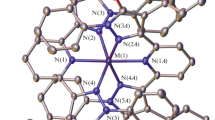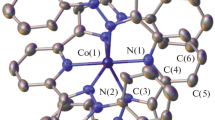Summary
Bivalent and trivalent cobalt complexes with 1-(2-pyridylazo)-2-naphthol (PAN), PAN+1, 10-phenanthroline and PAN+2, 2′-bipyridyl were prepared and characterized by physico-chemical and magnetic measurements. The spectral studies suggest that PAN behaves as a bidentate ligand and is coordinated to metal ions through oxygen and (pyridine) nitrogen, whereas 1, 10-phenanthroline and 2, 2′-bipyridyl are coordinated through (pyridine) nitrogen. The tentative ν(M−O) and ν(M−N) band assignments in the lower i.r. region, and magnetic moment data favour four coordination for the complexes studied.
Similar content being viewed by others
References
R. G. Anderson and G. Nickless,Analyst,92, 207 (1967).
A. Johnson, M. Sort and H. Jaffe,J. Am. Chem. Soc.,86, 2932 (1964).
A. F. Snavely,J. Inorg. & Nucl. Chem.,32, 455 (1970);33, 1831 (1971).
M. S. Masoud and F. Elzawawy,Talanta,27, 766 (1980).
A. Kaiser, A. Longemann and P. Zeller,Experimentia,20, 503 (1964).
K. Mochizuki and M. Fujimoto,Bull. Chem. Soc. Jpn.,53, 2531 (1980).
H. A. Flaschka,EDTA Titration, Pergamon Press, London, 1964.
D. Betteridge and D. John,Analyst,98, 377 (1973).
M. S. Masoud, T. M. Salem and M. A. Elhenawi,Synth. React. Inorg. Met.-Org. Chem.,11, 577 (1981).
E. König and K. Madeja,Inorg. Chem.,7, 1848 (1968).
P. C. H. Mitchell,J. Inorg. & Nucl. Chem.,25, 963 (1963).
E. König,Coord. Chem. Rev.,3, 471 (1968).
M. Goodgame and K. W. Johns,J. Chem. Soc., Dalton Trans., 1294 (1978).
P. M. Drozdzewski,Spectrochimica Acta,38A, 855 (1982).
B. N. Figgis and J. Lewis,Progress in Inorganic Chemistry, Interscience, New York, 1964.
A. E. Martell and M. Calvin,Chemistry of the Metal Chelate Compounds, Prentice Hall, Inc., New York, 1956.
M. Munakata,Bull. Chem. Soc. Jpn.,44, 1791 (1971).
A. B. P. Lever,Inorganic Electronic Spectroscopy, Elsevier, Amsterdam, 1968.
F. A. Cotton and G. Wilkinson,Advanced Inorganic Chemistry, 3rd edition, Wiley Eastern, New Delhi, 1979. (1963).
T. Iwamoto and M. Fujimoto,Anal. Chim. Acta,29, 282 (1963).
D. R. Eaton and W. D. Phillips, in J. S. Waugh (Ed)Advances in Magnetic Resonance, Academic Press, London, 1965.
Author information
Authors and Affiliations
Rights and permissions
About this article
Cite this article
Sastry, M.S., Ghose, R. & Ghose, A.K. Simple and mixed complexes of cobalt(II) and cobalt(III) ions. Transition Met Chem 13, 447–450 (1988). https://doi.org/10.1007/BF01043709
Received:
Issue Date:
DOI: https://doi.org/10.1007/BF01043709




